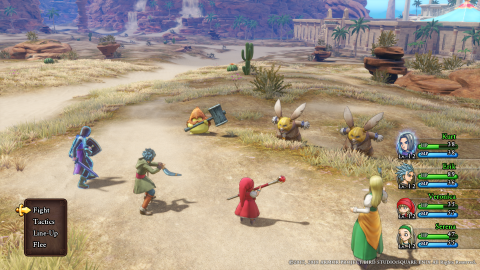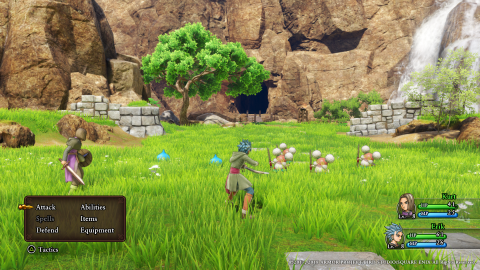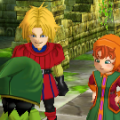- Dragon Quest (Introduction)
- Dragon Quest
- Dragon Quest II
- Dragon Quest III
- Dragon Quest IV: The Chapters of the Chosen
- Dragon Quest V: Hand of the Heavenly Bride
- Dragon Quest VI: Realms of Revelation
- Dragon Quest VII: Fragments of the Forgotten Past
- Dragon Warrior VIII: Journey of the Cursed King
- Dragon Quest XI: Echoes of an Elusive Age
- Slime Mori Mori Dragon Quest
- Dragon Quest Heroes: Rocket Slime
- Slime Mori Mori Dragon Quest 3
- Dragon Quest Heroes
- Dragon Quest Heroes II
The ninth entry of the Dragon Quest series went portable for the Nintendo DS, while the tenth entry was an MMORPG that never left Japan. Dragon Quest XI: Echoes of an Elusive Age brings the series back onto single-player adventuring, as well as returning it to consoles…kind of. Two versions were developed simultaneously – an HD version for the PlayStation 4 and Windows, and a portable version for the 3DS that was only released in Japan. A technological gulf between two platforms is massive, so the 3DS release isn’t just downscaled from the HD version, but rather a whole new game that follows the same story and has most of the same mechanics.
The story begins as the Hero, a youth from the quaint Cobblestone, discovers he is the Luminary, the reincarnation of a legendary warrior, and is destined to save the world from darkness. At his mother’s behest, the Hero leaves his home village and ventures to the neighboring city, Heliodor. Things do not go as planned, as King Carnelian, ruler of Heliodor, calls the Hero the Darkspawn, one whose birth precedes evil and the Lord of Shadows’ coming. With the help of the second party member, Erik, the Hero escapes the clutches of King Carnelian and his formidable knights. The duo travel across the land of Erdea helping those in need at every town and city along the way. He also meets new party members, each having a personal reason for fighting alongside the Hero. They also frequently encounter two knights from Heliodor, Sir Hendrik and Sir Jasper, who try to slay the Hero. Their adventures eventually put them in conflict with an evil sorcerer named Mordegon.
Characters:
Hero
The Hero is the reincarnated Luminary, a figure of legend in the world of Erdrea. He uses his extraordinary powers to save the world from darkness. He learns more about his ancestry on his journey, including his birth parents’ fate, and he takes care of his predecessor’s unfinished business.
Erik (Kamyu):
Erik is a world-traveling thief who befriends the Hero at the behest of the elusive Seer. His upbringing as a slave to the Vikings, and the loss of his sister, Mia, hardened him, but his friends help him open up and overcome his past.
Veronica
Veronica has been cursed with the appearance of a child despite being an adult. However, her appearance masks her wisdom and magic abilities. She is the more outgoing Arborian twin and always stands up for her sister, Serena. Her devotion to the Luminary guides her, and she does everything in her power to protect her friends.
Serena (Senya):
Serena is Veronica’s twin sister, and is the soft-spoken healer of the party, who plays her harp to cast protective hymns. She is always a few steps behind Veronica in life, but when her sister dies saving their companions, she becomes more assertive and expands her magical capabilities.
Sylvando (Silvia):
Sylvando’s litheness and flamboyant charm brought him celebrity status as a traveling circus performer. He joins the Hero and his companions to cheer up the world while keeping his past a secret.
Rab (Row):
The once-thought-dead king of Dundrasil, Rab, traveled the world, determined to find out why tragedy befell his home. After reuniting with his grandson, the Hero, he properly mourns his daughter and son-in-law before joining the party to find Mordegon.
Jade (Martina):
Jade hid her identity as the Princess of Heliodor after Mordegon possessed her father, King Carnelian, and destroyed Dundrasil. She saved the Hero from the destruction of his home but lost him down a river. Her actions are motivated by that event and her desire not to lose the Hero again.
Hendrik (Greig):
Duty and honor define Hendrik, and his strength comes from his desire to protect the most vulnerable. As a sworn knight of Heliodor, Hendrik is a foe of the Hero and chases him relentlessly.
The console version Dragon Quest XI most closely resembles Dragon Quest VIII, though now in HD. The characters still have some slight cel-shading, but the environments don’t, so it doesn’t look quite as cartoony as DQVIII. The 3DS version has simplified environments and characters with smaller proportions.
It’s also seen a number of quality-of-life improvements. Since the hero can now jump, the environments have more mountains and other areas to scale, and like the 3DS remakes of earlier titles, enemies are now visible on field. You can also get a horse for even faster travel, plus there are several types of monsters that can be ridden when defeated, given you extra abilities that are typically useful in dungeons. There are statues regularly placed through the areas that let you heal and save you game, plus there’s an autosave system so you’re never far from losing progress. If you get wiped out, you’re given the choice to either resume at the last autosave, or use the classic Dragon Quest option where you return a church/statue with half your gold but otherwise keeping everything else you obtained.
Rather than the open overworld of Dragon Quest VIII, Erdea is broken up into several large interconnected areas, though the world is still quite massive, with lots to see and explore. Crafting has also returned with the new portable Fun-Sized Forge, helping drive the player to look around each area to find components to build new weapons, armor, and accessories. Party Talk returns from previous titles as a way to find out where to go next, and Rab provides “previously on” style openings whenever a game save is loaded, giving you an idea of where you go if you haven’t played for a long time. As expected, the game also includes two casinos with unique rewards, and other optional activities like horse racing.
Battles are fought from a third person perspective (with a classic mode available) and are fully animated. You can actually move your characters around the field, though their positioning doesn’t actually affect the combat at all. Players can set the speed of the action and have several options for engaging in automatic battles. These additions help alleviate combat monotony and make Dragon Quest XI one of the most beginner-friendly JRPGs.
Rather than each side getting their own turn, combatants act based on their speed. The Tension system is gone, replaced with a new Pep system, which will pseudo-randomly put a character (friend or foe) in a heightened state with a blue glow, increasing their powers, which last for a handful of turns (and carries over between battles). Each character has special abilities when Pepped Up, though their Pep expires when this is used. There are also combo moves specific to character pair-ups when two or more party members are Pepped Up. The fact that you can’t directly activate Pep means that battles don’t feel quite as strategic as before, but choosing how to take advantage of it when it does activate makes for some interesting fights.
Because of some of these changes, the pacing and flow is quite a bit different from past Dragon Quest games. Since save points are so frequent, and you can run past most encounters, dungeons usually end up going by pretty quickly, and the regular boss battles generally aren’t too difficult either. For those who want more of a challenge, there are several Draconian modifiers that tweak the combat to make it more engaging, though sometimes these can get too hard, as it doesn’t really feel like the game was balanced for them.
Upon leveling up, you’re given points you can allocate into various skills. This is similar to Dragon Quest VIII, though rather than upgrading skills in a linear fashion, you’re presented with a board that allows you to unlock squares with various enhancements and moves. When you unlock a square, you open up all of the ones around it, allowing you a little more flexibility. It’s restricted compared to the Class customization systems of previous games, though since there are plenty of playable characters, there are still plenty of party configurations you can mess around with.
For most of the first act, the story doesn’t move much. Like Dragon Quest III, many of the locations you visit are based on real life places on Earth like Italy, Japan, and the Polynesian islands. Things pick up when you reach the massive tree, Yggdrasil, which holds significant spiritual importance to the people of Erdrea. It’s here that the evil Mordegon arrives, whose appearance sends shockwaves around the world.
The throughline of Dragon Quest XI‘s story is learning how to overcome past trauma, and Act II developers similarly to the World of Ruin in Final Fantasy VI. After their encounter with Mordegon, the Hero retraces his steps to reunite with his friends. Before each member of his team rejoins the party, they must first bear witness to the traumatic experiences that have shaped their lives and grow stronger by wrestling with them. From helping Sylvando find the strength to reconnect with his father, to being at Serena’s side as she mourns her tragic losses, each of these steps leading up to Mordegon sees the characters rise above their emotional wounds and come out feeling better about themselves.
By the end of Act II, the party features some of the most defined characters in the series, making Act III’s twist all the more emotional. While the heroes may have saved the world, there were still many tragic losses, but the hero is given the ability to travel back in time and prevent many of these from occurring in the first place. However, him and only him alone can go to the past, so he needs to say goodbye to his friends as he sets back to rewrite history. He meets them again, of course, but without any of the memories they’ve built together.
It’s here where players will likely either fall in love with Dragon Quest XI or burn out on it. The credits technically roll after Act II so Act III is something of a post game. But it’s also an expansive one with quite a bit of story, including opening up the path to the true ending. However, it means you also need to replay a significant chunk of the game to see all of these changes to the world. The first two Acts are already pretty lengthy, so this one makes it even longer, though it’s not like the Dragon Quest series is new to long and exasperating games.
The PlayStation 4 and 3DS versions share the same story and a majority of gameplay mechanics though the 3DS version uses the more traditional side-by-side turn order. In Japan, there was also an option to generate a password that let you take progress between the two versions. The 3DS version also includes Super Famicom-style graphics on the bottom screen, making it look like Dragon Quest VI. Also in this version is an additional side story that sees the player visit the worlds of past Dragon Quest titles, as well as some StreetPass minigames.
Only the PlayStation 4 version was initially released in North America, though it adds in voice acting that wasn’t originally present in the Japanese games. Like previous entries, it features a heavily stylized localization with plenty of amusing accents and goofy puns, particularly the monster names. (The hat-wearing warthogs called the Sham hatwitch are quite amusing.) However, this version uses a sequenced soundtrack, similar to the original Japanese release of DQVIII, and it sounds quite poor. It doesn’t help that the soundtrack in general is a little bland compared to past entries, and the amount of new songs is limited, recycling quite a bit of old music from past games.
A Definitive Edition was later issued for the Nintendo Switch. This includes some more quality of life enhancements, including speedier combat options and the ability to run. This version can be played with either 3D or 2D modes with Super Nintendo-inspired graphics, allowing you to switch between chapters. Combat in 2D mode is more akin to 8-bit and 16-bit Dragon Quest titles, with each character’s actions being selected before they all play out. It also includes most of the 3DS exclusive content like the quests based on older games, revolving around finding cutesy little spirits called Tockles. There are also added vignettes that serve as a transition between Acts I and II, as well as several new character specific stories. This version mercifully includes the option for orchestrated music, and was the first version to get voice acting in Japan. The visuals are slightly downgraded – there are some minor effects missing, the resolution is lower, and the colors aren’t quite as vibrant – but it still looks decent enough.
The Definitive Edition was later backported to the PlayStation 4, Xbox One, and Windows. However, the visuals are based on the downgraded Switch release, so it actually looks a little worse than the originally released version, though the quality gap isn’t enormous. The upside is that the PlayStation 4 version now runs at 60 FPS (rather than 30) on a PS4 Pro. All Windows versions can run at 60 FPS, too.
Overall, while the story starts off a little slow and typical, eventually goes some interesting places, and the cast of characters is the best the franchise has ever seen – Sylvando ranks up next to Yangus as one of the most charming in all of JRPG-dom. As always, it is very much a “traditional” JRPG, but the many enhancements to speed up both travel and combat make it smoother than ever before, resulting in a true classic, and one of the best in the series.



